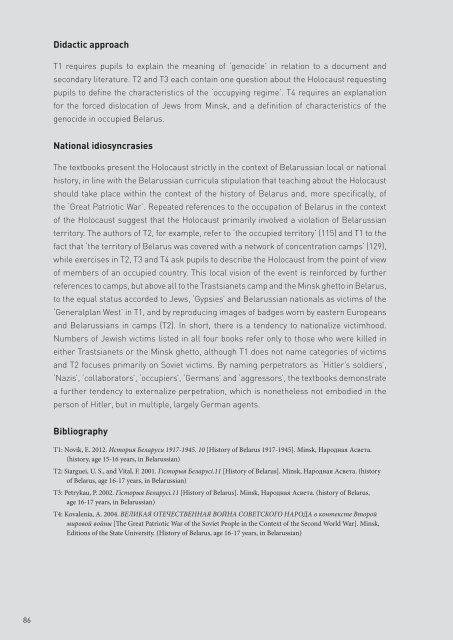228776e
228776e
228776e
Create successful ePaper yourself
Turn your PDF publications into a flip-book with our unique Google optimized e-Paper software.
Didactic approach<br />
T1 requires pupils to explain the meaning of ‘genocide’ in relation to a document and<br />
secondary literature. T2 and T3 each contain one question about the Holocaust requesting<br />
pupils to define the characteristics of the ‘occupying regime’. T4 requires an explanation<br />
for the forced dislocation of Jews from Minsk, and a definition of characteristics of the<br />
genocide in occupied Belarus.<br />
National idiosyncrasies<br />
The textbooks present the Holocaust strictly in the context of Belarussian local or national<br />
history, in line with the Belarussian curricula stipulation that teaching about the Holocaust<br />
should take place within the context of the history of Belarus and, more specifically, of<br />
the ‘Great Patriotic War’. Repeated references to the occupation of Belarus in the context<br />
of the Holocaust suggest that the Holocaust primarily involved a violation of Belarussian<br />
territory. The authors of T2, for example, refer to ‘the occupied territory’ (115) and T1 to the<br />
fact that ‘the territory of Belarus was covered with a network of concentration camps’ (129),<br />
while exercises in T2, T3 and T4 ask pupils to describe the Holocaust from the point of view<br />
of members of an occupied country. This local vision of the event is reinforced by further<br />
references to camps, but above all to the Trastsianets camp and the Minsk ghetto in Belarus,<br />
to the equal status accorded to Jews, ‘Gypsies’ and Belarussian nationals as victims of the<br />
‘Generalplan West’ in T1, and by reproducing images of badges worn by eastern Europeans<br />
and Belarussians in camps (T2). In short, there is a tendency to nationalize victimhood.<br />
Numbers of Jewish victims listed in all four books refer only to those who were killed in<br />
either Trastsianets or the Minsk ghetto, although T1 does not name categories of victims<br />
and T2 focuses primarily on Soviet victims. By naming perpetrators as ‘Hitler’s soldiers’,<br />
‘Nazis’, ‘collaborators’, ‘occupiers’, ‘Germans’ and ‘aggressors’, the textbooks demonstrate<br />
a further tendency to externalize perpetration, which is nonetheless not embodied in the<br />
person of Hitler, but in multiple, largely German agents.<br />
Bibliography<br />
T1: Novik, E. 2012. История Беларуси 1917-1945. 10 [History of Belarus 1917-1945]. Minsk, Народная Асвета.<br />
(history, age 15-16 years, in Belarussian)<br />
T2: Siarguei, U. S., and Vital, F. 2001. Гiсторыя Беларусi.11 [History of Belarus]. Minsk, Народная Асвета. (history<br />
of Belarus, age 16-17 years, in Belarussian)<br />
T3: Petrykau, P. 2002. Гiсторыя Беларусi.11 [History of Belarus]. Minsk, Народная Асвета. (history of Belarus,<br />
age 16-17 years, in Belarussian)<br />
T4: Kovalenia, A. 2004. ВЕЛИКАЯ ОТЕЧЕСТВЕННАЯ ВОЙНА СОВЕТСКОГО НАРОДА в контексте Второй<br />
мировой войны [The Great Patriotic War of the Soviet People in the Context of the Second World War]. Minsk,<br />
Editions of the State University. (History of Belarus, age 16-17 years, in Belarussian)<br />
86




